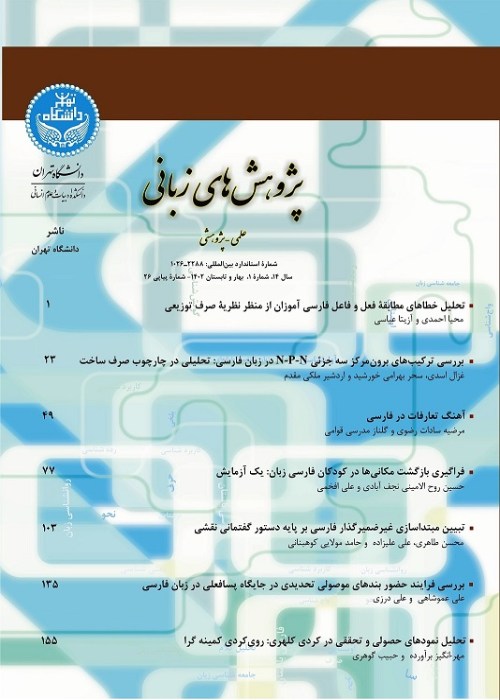The Evolution of Verbal Prefix mi in Persian Language
Author(s):
Article Type:
Research/Original Article (دارای رتبه معتبر)
Abstract:
This paper explores the evolution of the inflectional verbal prefix mi and its diverse roles from the Old Persian through the Middle Persian language, to the New Persian. In the earlier stages of Persian, verbal prefixes played varied roles, such as the adverbial function. Verbal prefixes could extend or restrict the principal meaning of the verb, or even change it altogether. The majority of verbal prefixes could originally be used both as adverbs and prepositions. However, the middle period of the Persian language witnessed a gradual reduction in the functional roles verbal prefixes played, as the language drifted toward analyticity. For this reason, verbal prefixes were no more able to change the verb meaning as they used to in the earlier stages. In other words, they changed to be fixed prefixes which were not generative anymore in middle Persian and the later stages of the language. In fact, verbal prefixes were grammaticalized and accepted various grammatical roles. This prefix is the contemporary Persian mi that represents the durative or habituative aspect. This inflectional prefix mi originates from old *ham-aiwa through the middle Persian hamē which means “always” in Middle Persian. Hamē also represents continuity and habits, while it does not have a fixed place in the sentence having been attested in a variety of places. In classical Persian literature texts, hamē is attested in the forms of hami and mi. The two classical Persian forms gradually moved closer to the verb, and were finally attached to the verb to be grammaticalized as an inflectional prefix. Contemporary mi represents not only continuity and habit, but also plays a modal role to signify unfulfilled wishes and unrealized assumptions by prefixing a past verb. Thus, the adverbial *ham-aiwa has gone through a long process of grammaticalization, and has become an inflectional prefix to signal continuity and habits aspect and also irreal modality.
Keywords:
Language:
Persian
Published:
Language Research, Volume:11 Issue: 2, 2021
Pages:
271 to 285
magiran.com/p2260082
دانلود و مطالعه متن این مقاله با یکی از روشهای زیر امکان پذیر است:
اشتراک شخصی
با عضویت و پرداخت آنلاین حق اشتراک یکساله به مبلغ 1,390,000ريال میتوانید 70 عنوان مطلب دانلود کنید!
اشتراک سازمانی
به کتابخانه دانشگاه یا محل کار خود پیشنهاد کنید تا اشتراک سازمانی این پایگاه را برای دسترسی نامحدود همه کاربران به متن مطالب تهیه نمایند!
توجه!
- حق عضویت دریافتی صرف حمایت از نشریات عضو و نگهداری، تکمیل و توسعه مگیران میشود.
- پرداخت حق اشتراک و دانلود مقالات اجازه بازنشر آن در سایر رسانههای چاپی و دیجیتال را به کاربر نمیدهد.
In order to view content subscription is required
Personal subscription
Subscribe magiran.com for 70 € euros via PayPal and download 70 articles during a year.
Organization subscription
Please contact us to subscribe your university or library for unlimited access!


